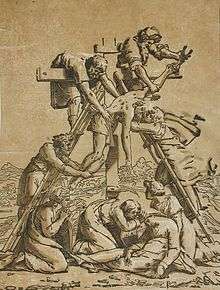Ugo da Carpi



Ugo da Carpi (c. 1480 – between 1520 and 1532), painter and printmaker, the first Italian practitioner of the art of the chiaroscuro woodcut, a technique involving the use of several wood blocks to make one print, each block cut to produce a different tone of the same colour.[1]
Works
In 1516, he requested from the Venetian senate a patent for his method "of making from woodcuts prints that seem as though painted". His prints translate designs by artists such as Raphael, Baldassare Peruzzi, and Parmigianino, including one entitled "Hercules Chasing Avarice from the Temple of the Muses" after Peruzzi's design.
His best known engravings include "A Sybil", "Descent from the Cross", and "History of Simon the Sorcerer".
Recently, some historians have speculated that some frescoes found in Civitavecchia have been painted by the artist. [Citation needed]
References
- ↑ "Ugo da Carpi." Encyclopædia Britannica. Encyclopædia Britannica Online. Encyclopædia Britannica, 2011. Web. 24 Feb. 2011.
External links
![]() Media related to Ugo da Carpi at Wikimedia Commons
Media related to Ugo da Carpi at Wikimedia Commons